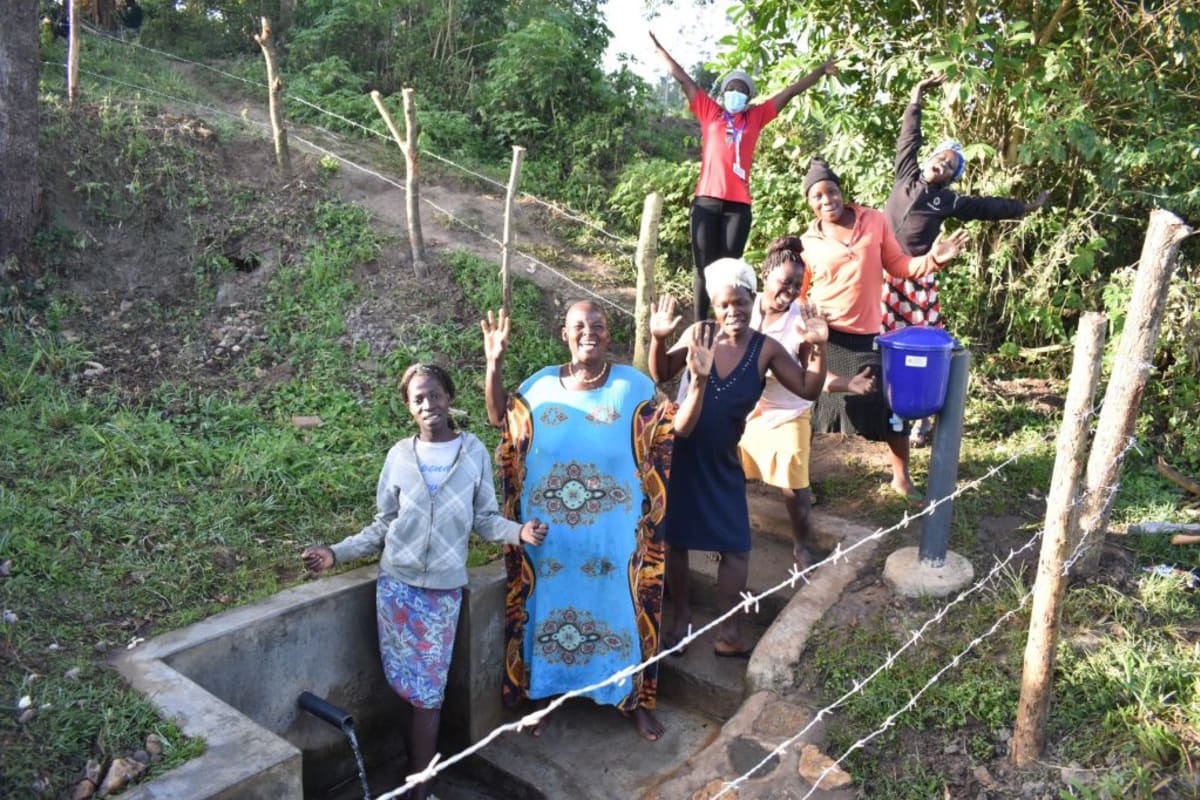Matiang'i Spring is located in Mwituwa village, where it serves 420 people. As it is located near the road, the spring serves many people. Most men in this community do not stay at home during the day, so the burden of fetching water is left to the women and children. Women are also expected to clear the bushes that grow in and around the spring, and ensure that the spring is maintained.
But with the very busy and tiring schedule that a typical woman has, it leaves her with little time to take care of the spring effectively. Women are the ones who wake up early, prepare the children for school, clean the compound, milk the cows, and ensure there is breakfast for their entire family. In this community, women are at the center of ensuring there is a meal on the table each day, regardless of the work they have to do. Their afternoons and evenings are filled with farm work, house chores, and more trips to the spring. Most women in this community also do manual labor on others' farms, for which they are paid per day. When they have to go looking for water, they miss out on time they could be working to earn a living.
So much time is lost at Matiang'i Spring due to its unprotected state. The community tried to improvise a headwall using mud in an attempt to build up enough pressure for the water to flow through a makeshift pipe. But without any other materials available or the technical knowledge of how to protect the spring, their efforts are frequently washed away in the rain. Water also escapes through either side of the mud wall, and sometimes straight through it. This leads to slower fill times for every container someone brings to the spring.
"Sometimes you come to fetch water and find the pipe missing, which makes you go back home and bring the jug. This is time-consuming, especially when I want to go to school," said primary school student Amos. Most children are asked to fetch water for their families before they attend school, leading to missed morning classes and later, absenteeism when they get sick from the spring water.
The spring remains an open source, with algae and dirt mixing in the water people collect. To reach the pipe, people also have to stand in several inches of mud and water that pool beneath the pipe, and their containers become flush with the standing water as they begin to fill. It is not uncommon to accidentally get some of the standing water mixed in with the water from the pipe. The access area means "getting water is difficult sometimes," said 25-year-old farmer Jacinta Mukoya.
This unprotected water source leads to the community spending extra money buying chlorine so as to treat the water, though not everyone can afford it. Those who can on occasion are spending resources that could be channeled to other crucial needs, like purchasing food or materials for their farms. A lot of productive time is also lost while lining up to fetch water from this water source, as people try to let the water settle between users. But with so many people waiting their turn, they can only wait so long. The crowds and lines are especially concerning during the pandemic, when community members are trying to avoid groups and limit their time spent in public.
Community members report widespread cases of diarrhea after drinking the spring water. Falls and their related injuries are also common from people trying to leave the spring with their heavy containers, since there are no stairs to aid in accessing the water point.
What We Can Do:
Spring Protection
Protecting the spring will help provide access to cleaner and safer water and reduce the time people have to spend to fetch it. Construction will keep surface runoff and other contaminants out of the water. With the community’s high involvement in the process, there should be a good sense of responsibility and ownership for the new clean water source.
Fetching water is a task predominantly carried out by women and young girls. Protecting the spring and offering training and support will, therefore, help empower the female members of the community by freeing up more of their time and energy to engage and invest in income-generating activities and their education.
Training on Health, Hygiene, COVID-19, and More
To hold trainings during the pandemic, we work closely with both community leaders and the local government to approve small groups to attend training. We ask community leaders to invite a select yet representative group of people to attend training who will then act as ambassadors to the rest of the community to share what they learn. We also communicate our expectations of physical distancing and wearing masks for all who choose to attend.
The training will focus on improved hygiene, health, and sanitation habits in this community. We will also have a dedicated session on COVID-19 symptoms, transmission routes, and prevention best practices.
With the community’s input, we will identify key leverage points where they can alter their practices at the personal, household, and community levels to affect change. This training will help to ensure participants have the knowledge they need about healthy practices and their importance to make the most of their water point as soon as water is flowing.
Our team of facilitators will use a variety of methods to train community members. Some of these methods include participatory hygiene and sanitation transformation, asset-based community development, group discussions, handouts, and demonstrations at the spring.
One of the most important issues we plan to cover is the handling, storage, and treatment of water. Having a clean water source will be extremely helpful, but it is useless if water gets contaminated by the time it is consumed. We and the community strongly believe that all of these components will work together to improve living standards here, which will help to unlock the potential for these community members to live better, healthier lives.
We will then conduct a small series of follow-up trainings before transitioning to our regularly scheduled support visits throughout the year.
Training will result in the formation of a water user committee, elected by their peers, that will oversee the operations and maintenance of the spring. The committee will enforce proper behavior around the spring and delegate tasks that will help preserve the site, such as building a fence and digging proper drainage channels. The fence will keep out destructive animals and unwanted waste, and the drainage will keep the area’s mosquito population at a minimum.

 Protected Spring
Protected Spring
 Rehabilitation Project
Rehabilitation Project











































